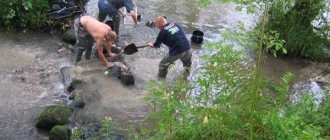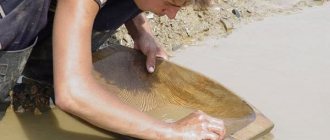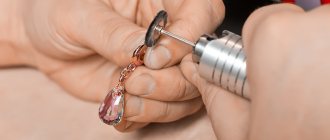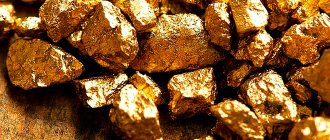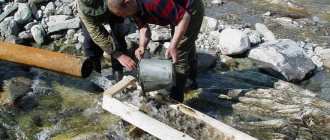Where do miners find gold in Russia?
The largest Au deposits are located in the Far East and Eastern Siberia. The third place is occupied by the Urals.
Below is a list of rivers containing the largest reserves of the yellow metal - this is where I recommend finding and washing it.
Yellow metal satellites
Companion rocks that play the role of “witnesses”, suggesting that gold-bearing veins are somewhere nearby:
- silver;
- pyrite;
- quartz;
- lead;
- galena.
Pyrite is the most insidious companion of gold, because beginners often cannot distinguish it from a real noble metal: they find a mass of pyrite crystals and rejoice at the happiness that has fallen on their heads, and then they are disappointed.
Meanwhile, gold can not only be washed from the river, but also found inside inconspicuous-looking pieces of rock scattered along the shore. If a piece of mineral glitters with a yellow tint that does not change when light is refracted, there is most likely gold inside. This breed should be crushed and washed.
Why do they wash gold in the river?
Extracting gold from the river is the most accessible way for single miners to get hold of the precious metal. To find it in river beds and wash it out of rock, you do not need to purchase expensive equipment and hire personnel, as with industrial mining from the subsoil.
There is definitely Au in the rivers flowing near gold deposits; there is a simple popular scientific explanation for this. Temperature changes and other natural phenomena destroy gold-bearing ores, small particles of the precious metal are washed away by rain, melt and flood waters into rivers and streams. After which, being heavy, gold settles in certain places:
- terrace deposits are found on rapids and sills that rise above the level of the banks of watercourses, as well as in dry riverbeds;
- Bottom placers should be looked for in bedrock channels (in valleys);
- spit deposits are formed on river spits, whether sandy or pebbly.
It is good to find and wash small gold grains and large or small nuggets in bedrock, places where the flow of water slows down (the mouths of mountain streams, turns of riverbeds), natural “traps” (near boulders lying in a mountain river, on shallows, in pits under waterfalls, near fallen trees blocking the river flow).
Geography of gold mining and a little history
For the first time, humanity began to find gold where ancient civilizations had already settled, for example, in northern Africa, India, Mesopotamia and the Mediterranean. Not long ago, scientists tried to calculate how much gold people managed to extract throughout history. The figure is truly enormous: over one hundred thousand tons.
The ancient world sourced its gold from Egypt, which believed its supply was endless. Sudan kept pace with Egyptian gold mining and also produced large volumes of pure gold. In third place it is worth noting Africa, which, for certain reasons, transported all the gold mined to Egypt.
Gold mining sites in Ancient Egypt.
If we talk about the Middle Ages, then gold production was the lowest in the entire history of mankind.
After America was discovered, world gold reserves began to increase sharply, since this country has always been rich in its deposits. Central America has taken first place in the world in reserves of precious metals.
As you know, gold is a finite resource. Therefore, it is not surprising that the geography of gold deposits changes from year to year. And these changes are often quite radical.
For example, let's take the 80s, when world gold reserves were replenished by more than 940 tons. The majority of all these reserves were mined in South Africa, specifically 675 tons. And so it was for ten years. By the beginning of the 2000s, the main mining sites moved to Latin America, while gold production in South Africa began to decrease by 35%.
Australia has always been full of gold deposits and has always tried not to be inferior to the “golden” powers, each time finding more and more new mines in its depths.
Is it possible to mine gold in Russia?
Until 2021, only large legal entities had the right to engage in gold mining. The activities of private miners who dared to wash the precious metal were completely illegal and criminally punishable.
Currently, private individuals have the right to extract gold from deposits - under two conditions:
- individual entrepreneur registration;
- availability of a license or agreement with a gold mining organization that has all the permits for the development of gold mines.
Obtaining a license is a long and troublesome procedure; concluding an agreement with a licensed gold mining company is a much simpler path.
Industrial mining of precious metals brings companies quite high incomes. And private miners who want to pan for gold using the artisanal method are not competitors for them. So we can reach an agreement.
What laws regulate gold mining?
Business entities have the right to engage in gold mining in the Russian Federation, guided by the federal law “On Subsoil”, after the adoption of a number of amendments allowing both legal entities and individual entrepreneurs to mine gold from the beginning of 2021. Any private miner is given the opportunity to rent a plot of land of up to 0.15 square meters for a specified period, which is enough to extract up to 10 kilograms of precious metal.
A few more conditions must be met:
- obtain metal only by surface method;
- exclude the use of explosives;
- take soil only up to 5 meters deep.
If you wash precious metals without a license or an agreement with a company that has one, this activity is still punishable under Art. 191 of the Criminal Code of the Russian Federation. And violation of these requirements threatens with serious sanctions.
Permitted Miner's Tools
Tools that help you find and wash precious metals:
- Mini-drag for pumping rock from the bottom of the river (no deeper than 5 m) and washing it away.
- A tray in which it is convenient to wash the rock by hand.
- A metal detector that detects the presence of metal in the soil. A conventional device reacts not only to gold, but also to any metal, so I advise you to use a special metal detector with a sensor that can be easily configured specifically to search for gold.
What is a tray and why do you need a magnet?
A tray is a special device for washing rock and separating Au from it. With it you can do without a mini-dredge and get soil out of the river with an ordinary shovel.
The magnet helps separate black sand from base metals from Au.
In addition to the tray and magnet, I advise you to purchase a bulb bottle, which helps you easily remove precious particles from the tray at the last step of lathering.
It is more convenient to place gold grains in a glass bottle.
What do they do with the mined gold?
Since illegal gold cannot be sold or sent for refining, people process and refine it themselves. The further fate of illegally mined gold can develop according to the following schemes:
- Amalgamation. The method is suitable for small particles obtained by laundering. It consists of combining a precious metal with mercury and then separating the amalgam from other elements. At the final stage, gold and mercury are also separated.
- Cyanidation. Gold goes through several stages, including leaching. The purity of the resulting precious metal is much higher than after the previous method. But cyanide fumes are hazardous to health.
- Chlorination using chlorine and hydrochloric acid.
Of course, gold mining using artisanal methods is difficult physical work. But in the end she fed more than one family. As long as countries experience economic instability, the activities of black diggers cannot be avoided.
How to properly wash gold with a tray
Now that we've sorted out the tools, I'll describe the technology for panning gold by hand.
It consists of three washing stages:
- large rocks and dirt;
- gravel and ordinary sand;
- black sand.
Washing away dirt and large rocks
- Fill the tray three-quarters full with rock, dip it into the stream so that the edges are above the surface of the water.
- Shake the tray back and forth and left and right, sharply but gently, without shaking out the gravel.
- After several shakes, we rotate the tray, moving the gravel in a circle, while most of the dirt inside dissolves.
- We remove the moss and roots and rub them over the tray with our fingers, checking to see if there are any gold particles in them.
- We take out large stones and check if they are washed.
We continue to wash with shaking and circular movements until large rocks and dirt are removed.
Washing out sand and gravel
- Holding the tray above the water surface, tilt it slightly away from you.
- We rotate it, shaking it from time to time in an upward motion, as if tossing a steak in a frying pan, but without throwing out the gravel and not letting it wash over the edge.
- Shake the tray (still in water) back and forth.
- Repeat steps 1-3 to thoroughly rinse the contents of the tray until only heavy rock remains at the bottom.
It consists of black sand, which, if the miner is lucky, contains grains of gold.
Washing out black sand
- We take the tray out of the watercourse. We do not pour out the water remaining at the bottom; it will be useful at the last stage of washing.
- We tilt the tray a little and slowly turn it in a circle, checking if there are any precious pieces of gold or small nuggets at the bottom. If there is any, remove it and put it in a container for storing the “catch”.
- Slowly pass a magnet over the black sand. Black sand sticks to it, separating from the golden grains.
- We take a pear bottle, squeeze it and, unclenching it, suck up the gold and water from the tray.
- Pour the remaining black sand and gold grains into a container for precious metal.
You can finish washing and cleaning black sand, extracting the smallest Au particles from it, at home.
Gold mining in Bashkiria
At the Russian level, Bashkiria is one of the largest gold producers. Thus, in 2015, approximately 7.5 tons of precious metals were mined on Bashkir territory, among which gold was not the least important.
On the territory of Bashkortostan there are four main regions where gold has been mined for a long time. All deposits have differences in the nature and composition of the metal mined there:
- Sakmaro-Tanalyk zone – placers,
- The Uchalinsky district is predominantly a gold-sulfide deposit,
- Baymaksky district - this area is characterized by gold-polymetallic mining,
- Beloretsky district. In the Uchalinsky and Baymaksky districts there is the largest concentration of quartz gold veins.
And throughout the east of the South Ural slope, gold-quartz compositions are dispersed. A certain number of them are also present in the areas of Upper Avzyan.
Most of the Trans-Ural deposits with sulfide ore are high-quality sources of both gold and copper.
The large concentration of precious deposits in Bashkiria is due to the number of oxidation zones in the deposits. Currently, geological work and the search for new gold deposits are being actively carried out in Bashkortostan. A number of potential rich sources have already been found.
Recently, private gold mining in abandoned mines was legalized here. Absolutely anyone can come here with a metal detector and start searching. True, the likelihood of finding something is small. Because these places have been walked far and wide by professionals a long time ago.
Choosing a place to wash gold
Tips on how to choose the best place to extract the richest rock from the water and wash the yellow metal with the greatest benefit:
- Search on a river or in a stream from the list of the most “gold-bearing” ones, not far from the place of industrial mining - after it, not only the smallest grains of gold remain, but also whole nuggets, which are enough for everyone.
- Choose a section of the watercourse with a depth of more than 15 centimeters so as not to wash the metal in too dirty water full of small debris.
- Choose a section of the river with a relatively slow (slow) flow.
- If you're lucky, find a place with a large stone or a fallen tree where you can sit down so as not to wash the precious metal while standing.
Statistics of gold mining enterprises
The main “drivers” of the growth of the gold mining industry in Russia are those enterprises that have well mastered the technology of mining the precious metal, and also produce more than 5 tons of gold annually. At the same time, the 10 largest enterprises produced a total of 93.5 tons of the yellow metal, despite the fact that this is 6.5% lower than last year’s figures, which are mainly due to unprofitable production at the Chukotka Mining and Gas Concentration Plant.
Lunnoe deposit in Yakutia
Gold mining in the Republic of Sakha has not undergone any significant changes, which allows the gold mining industry in this region to remain at a fairly good level. But enterprises in Yakutia stubbornly adhere to low profitability indicators, which is associated with an outdated material and technical base and insignificant investments.
Top 10 Russian rivers rich in gold reserves
The Golden Ten watercourses, where there are a lot of reserves and it’s profitable to wash:
- Alekseevsky stream (Kamchatka);
- Bodaibo River (Irkutsk region);
- tributary Bolshoi Chanchik (ibid.);
- Bom River (Amur region);
- Jalon stream (ibid.);
- the Lena River and its basin;
- Millionny stream (Amur region);
- Unakha River (ibid.);
- Sanarka River (Chelyabinsk region);
- Talga River (Khabarovsk Territory);
At Bodaibo and Millionnoye they wash the rock and extract the largest gold particles. Nuggets are also found in these and other watercourses.
Geology of placer deposits
A placer deposit is a concentration of natural gold accumulated in sediments. For example, in the beds of rivers and streams.
Gold produced by weathering or another process is likely to accumulate in placer deposits because of its light weight and corrosion resistance. In addition, its characteristic yellow color makes it easily and quickly recognizable even in very small quantities.
To extract gold of this type, special miner's trays and sieves are often used. They are a container made of sheet iron with sloping sides and a flat bottom, which is used for washing gold-bearing soil or other material containing heavy minerals. The alluvium is carefully sifted for valuable materials.
The material washing process is the simplest and most commonly used. This is a less expensive method of separating gold from silt, sand, and other stream sediments.
It's tedious work. And only with practice does a person become a professional in his activity.
Facts from the “golden” history of Bashkiria
The vast majority of the world's gold was mined in the modern post-war era. It is not known for certain how many centuries gold mining was carried out in the Southern Urals. But we can definitely say that it manifested itself at the end of the 18th century.
In the Uchalinsky district, even before revolutionary times, a large gold bar was somehow discovered, which weighed about 16 kg. And, after some period, they found another one - weighing 5 kg. He was given the name “Irndyk Bear” and placed in the local central museum. It is still possible to visually study it and even touch it today.
At the end of May 1812, the monopoly on the extraction of this metal was abolished. And all residents of Russia were allowed to search for gold ores. With the condition of further payment to the treasury. Until 26 of the same century, precious metals were mined by miners.
In the south of the Urals they used a chemical method for extracting gold. This happened in 86 of the 19th century, when a plant for processing ephels containing gold was built at one of the mines. The chlorination method was used.
In the period from 1832 to 1917, more than 42 tons of gold were extracted from the subsoil located in Bashkiria. About 28 tons mined occurred between 1885 and 1917. According to scientists, this clearly shows the cyclical nature of the gold mining industry and its dependence on economic and political factors.
By the 20th century, the industry had reached new heights. And this is precisely what contributed to the emergence of the socialist economy some time after the Civil War. It also improved industry throughout the republic.
In the first Soviet years, Buribayevskoye, Sibayskoye, Vostochno-Kuznechnoye and other well-known deposits were discovered. And in the east of the Uchalinsky district they discovered Blagodatnoye, Yuzhno-Remezovskoye and Krasnoohtinskoye.
